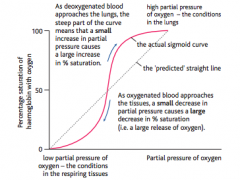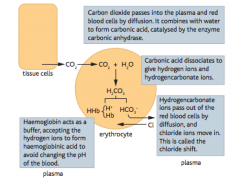![]()
![]()
![]()
Use LEFT and RIGHT arrow keys to navigate between flashcards;
Use UP and DOWN arrow keys to flip the card;
H to show hint;
A reads text to speech;
4 Cards in this Set
- Front
- Back
|
Oxygen |
• a haemoglobin molecule can pick up four molecules of oxygen and bind to them. The conc of O2 in the RBC when blood enters the lungs is low, hence diffusion of O2 into the blood takes place
• Oxygen binds to the haemoglobin which means that at no time will there be free oxygen in the blood thus a steep conc of oxygen is always maintained and hence more O2 is loaded
• In the cells the O2 conc is low in comparison to the blood so the O2 diffuse into the cells |
|
|
Carbon Dioxide |
• CO2 Diffuses from respiring cells into the blood along a concentration gradient.
• CO2 reacts with water in the blood to form carbonic acid which separates into H+ and HCO3-
• CO2 + H2O H2CO3 H+ + HCO3
• About 5% of the CO2 is carried in solution in plasma
• 10-20% is carried in haemoglobin forming Carbaminohaemoglobin
• The rest is in cytoplasm of blood as hydrogen carbonate ions. Enzyme carbonic anhydrase controls the rate of rxn between CO2 and water
• The H+ produced in the process are accepted by the haemoglobin acting as a buffer to prevent any pH changes of blood |
|
|
Fig 1.1.9 Oxygen dissociation curve for human haemoglobin |

|
|
|
Fig 1.1.10 the transport of carbon dioxide from the tissues to the lungs depends on the reaction of carbon dioxide with water . controlled by an enzyme in the red blood cells |

|

